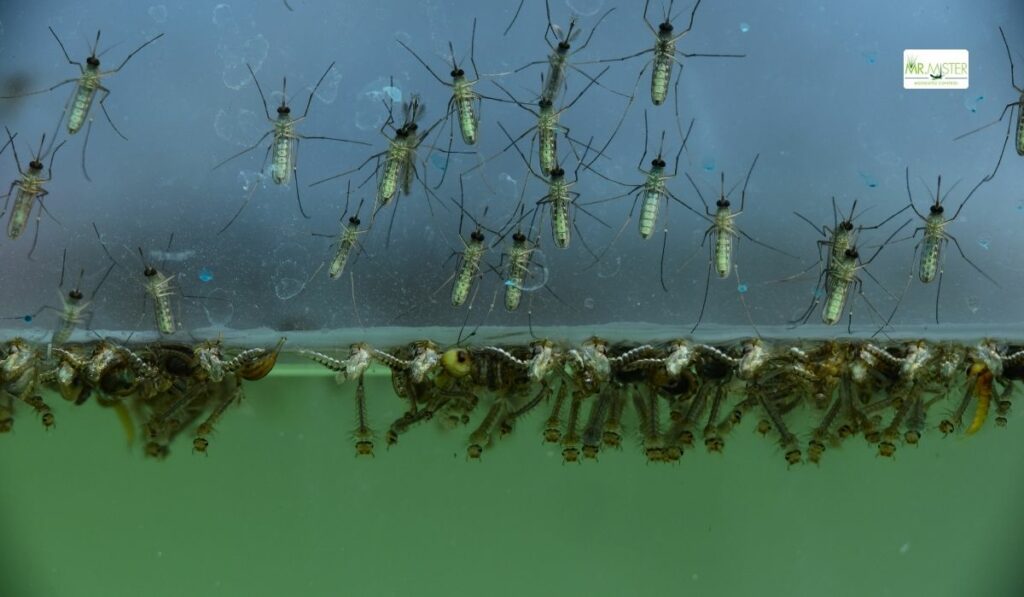Retention Pond Mosquito Control: Eco-Friendly Approaches
Serving Atlanta, Georgia and Surrounding Areas
Retention ponds, essential for managing stormwater runoff and preventing flooding in urban and suburban areas, often face challenges with mosquito infestations.
These bodies of water, while crucial for water management, can become breeding grounds for mosquitoes if not properly maintained.
Implementing sustainable and eco-friendly mosquito control approaches is not only essential for maintaining the functionality of retention ponds but also for preserving local ecosystems and minimizing environmental impact.
Understanding Retention Ponds and Mosquito Infestation
Retention ponds are artificial or natural depressions designed to collect and manage stormwater runoff.
They help reduce the risk of flooding by temporarily storing excess water and gradually releasing it into the environment or municipal drainage systems.
However, their stagnant water can attract mosquitoes, which lay eggs in standing water.
This creates a challenge for communities and environmental agencies to manage mosquito populations effectively without harming the pond’s ecosystem.
Sustainable Approaches to Mosquito Control
Biological Control Methods
Biological control methods utilize natural predators or pathogens to target mosquito larvae specifically.
One effective biological control agent is Bacillus thuringiensis var. israelensis (Bti), a naturally occurring bacterium that kills mosquito larvae upon ingestion.
Bti is non-toxic to other aquatic life, making it a safe and sustainable option for retention ponds.
Introducing native fish species like mosquito fish (Gambusia affinis) can also help control mosquito larvae populations without disrupting the pond’s ecosystem balance.
Mechanical Control Techniques
Mechanical methods involve physically disrupting mosquito breeding sites or preventing access to standing water.
This can include regular maintenance of the retention pond to remove debris and vegetation that provide shelter for mosquito larvae.
Installing floating barriers or screens at inlet and outlet points can prevent mosquito entry while allowing water flow, maintaining the pond’s functionality.
Vegetation Management
Proper vegetation around and within the retention pond can play a significant role in mosquito control.
Dense vegetation provides shaded areas and organic matter that encourage mosquito breeding.
Implementing strategic landscaping practices, such as planting native aquatic plants that naturally deter mosquitoes or using vegetation that doesn’t create excessive shade, can help reduce mosquito habitats while promoting biodiversity.
Integrated Pest Management (IPM)
IPM combines multiple strategies, including biological, mechanical, and chemical controls, in a targeted and environmentally sensitive manner.
This approach emphasizes monitoring and assessing mosquito populations, understanding their life cycles, and implementing interventions only when necessary.
By integrating sustainable practices into mosquito control plans, IPM minimizes the use of chemical pesticides that may harm non-target organisms and disrupt ecosystem balance.
Eco-Friendly Mosquito Control Products
Natural Larvicides
Natural larvicides, such as oils derived from plants like neem or extracts from certain bacteria and fungi, offer effective alternatives to synthetic chemical insecticides.
These products target mosquito larvae while posing minimal risk to other aquatic organisms and the environment.
Their biodegradable nature ensures that they break down without leaving harmful residues in the water or soil.
Biopesticides
Biopesticides are derived from natural materials like plants, animals, bacteria, and minerals.
They include microbial insecticides, such as those containing Bacillus thuringiensis strains, which selectively target mosquito larvae.
Biopesticides are designed to degrade quickly, reducing their environmental impact compared to conventional chemical pesticides.
Community Engagement and Education
Community involvement is crucial in implementing sustainable mosquito control practices for retention ponds.
Educating residents about the importance of maintaining retention ponds and adopting eco-friendly mosquito control methods can foster a sense of environmental stewardship.
Local governments and homeowners associations can collaborate on pond maintenance schedules, vegetation management plans, and monitoring efforts to ensure long-term success in mosquito control without compromising environmental health.
Environmental Benefits of Sustainable Mosquito Control
Preservation of Biodiversity
Sustainable mosquito control methods prioritize the preservation of biodiversity within retention ponds and their surrounding ecosystems.
By minimizing the use of chemical pesticides, which can harm non-target organisms such as fish, amphibians, and beneficial insects, these methods help maintain a balanced ecosystem.
Healthy biodiversity supports natural predators of mosquitoes, such as dragonflies and birds, which contribute to controlling mosquito populations naturally.
Protection of Water Quality
Retention ponds play a critical role in improving water quality by filtering pollutants from stormwater runoff before it enters local water bodies.
Chemical pesticides and fertilizers used in conventional mosquito control can degrade water quality and disrupt aquatic ecosystems.
Eco-friendly approaches like biological controls and natural larvicides minimize water contamination, ensuring that retention ponds continue to function effectively as natural water filters.
Practical Considerations for Implementing Eco-Friendly Mosquito Control
Monitoring and Surveillance
Regular monitoring and surveillance of mosquito populations are essential for effective mosquito control.
This involves assessing larval abundance, identifying species present, and monitoring adult mosquito activity.
By understanding local mosquito dynamics, communities can implement targeted control measures when necessary, reducing the overall need for intervention.
Community Participation and Education
Engaging local communities in mosquito control efforts fosters a sense of ownership and responsibility.
Educational programs can raise awareness about the ecological importance of retention ponds and the benefits of sustainable mosquito control practices.
Encouraging residents to eliminate standing water around their properties, properly maintain rain barrels and gutters, and participate in community clean-up events can complement professional mosquito control efforts.
Regulatory and Policy Considerations
Local Regulations and Permits
Before implementing mosquito control measures in retention ponds, it’s essential to understand local regulations and obtain necessary permits.
Some jurisdictions may have specific guidelines regarding the use of pesticides, the introduction of biological controls, and the maintenance of aquatic habitats.
Compliance with these regulations ensures that mosquito control efforts are conducted responsibly and in accordance with environmental laws.
Collaboration with Environmental Agencies
Collaboration between local governments, environmental agencies, and community stakeholders is crucial for effective retention pond management.
Agencies such as the Environmental Protection Agency (EPA) provide resources and guidance on sustainable mosquito control practices, ensuring that interventions are both effective and environmentally responsible.
Conclusion
Retention ponds are critical components of urban water management systems, but their stagnant waters can attract mosquitoes, posing health risks and ecological challenges.
Adopting sustainable and eco-friendly mosquito control approaches not only mitigates these risks but also preserves biodiversity and protects water quality.
By prioritizing methods such as biological controls, natural larvicides, and integrated pest management, communities can effectively manage mosquito populations while minimizing environmental impact.
Engaging in community education and collaborative efforts, and adhering to local regulations, ensures that retention pond management practices are both effective and environmentally responsible.
For more information on implementing sustainable mosquito control solutions for your retention pond, contact us at Mr. Mister Mosquito Control.
Together, we can promote healthier ecosystems and safer communities through responsible mosquito control practices.
FAQs
What is a retention pond?
Retention ponds are designed to manage stormwater runoff by temporarily storing excess water and gradually releasing it into the environment or drainage systems to prevent flooding.
Why do retention ponds attract mosquitoes?
Retention ponds can become breeding grounds for mosquitoes due to their stagnant water, which provides an ideal environment for mosquito larvae to hatch and grow.
How do mosquitoes affect retention pond functionality?
Mosquitoes can disrupt retention pond functionality by increasing the risk of disease transmission, reducing recreational usability, and potentially hindering stormwater management if left unchecked.
What are sustainable approaches to mosquito control in retention ponds?
Sustainable methods include biological controls like Bacillus thuringiensis var. israelensis (Bti), which targets mosquito larvae without harming other aquatic life, and introducing mosquito fish (Gambusia affinis) to consume larvae. Mechanical methods such as debris removal and installing barriers also help.
What are natural larvicides, and how do they help?
Natural larvicides derived from plants or bacteria, such as neem oil or Bacillus thuringiensis strains, effectively target mosquito larvae while minimizing environmental impact.
How does Integrated Pest Management (IPM) contribute to eco-friendly mosquito control?
IPM integrates multiple strategies like biological, mechanical, and minimal chemical controls in a targeted manner, reducing reliance on synthetic pesticides and promoting long-term environmental sustainability.
What role does community engagement play in sustainable mosquito control?
Community involvement is crucial for implementing and maintaining eco-friendly practices. Educating residents about mosquito control, encouraging property maintenance to eliminate standing water, and collaborating on monitoring efforts are key.
How can sustainable mosquito control benefit local ecosystems?
By minimizing chemical pesticide use, sustainable methods preserve biodiversity, protect water quality in retention ponds, and support natural predators of mosquitoes like dragonflies and birds.
What regulatory considerations are important for implementing mosquito control in retention ponds?
It’s essential to understand and comply with local regulations and obtain necessary permits for using pesticides or introducing biological controls to ensure responsible environmental management.
Where can I find resources on sustainable mosquito control practices for retention ponds?
Local environmental agencies and organizations like the Environmental Protection Agency (EPA) offer guidance and resources to support effective and environmentally responsible mosquito control efforts.
What are the risks associated with conventional mosquito control methods in retention ponds?
Conventional methods often involve the use of chemical pesticides that can harm non-target organisms, degrade water quality, and disrupt the natural balance of retention pond ecosystems.
How do biological controls like Bacillus thuringiensis var. israelensis (Bti) work?
Bti is a bacterium that produces toxins lethal to mosquito larvae when ingested. It specifically targets mosquitoes while posing minimal risk to other aquatic life forms, making it a safe and effective choice for sustainable mosquito control.
What are the benefits of introducing native fish species for mosquito control?
Mosquito fish (Gambusia affinis) are natural predators of mosquito larvae. Introducing them to retention ponds helps maintain mosquito populations naturally without disrupting the pond’s ecosystem balance.
* Schedule a Free Mosquito Control Consultation – 404-941-0720 *
* Guaranteed Results * 100% Biodegradable * Locally Owned



